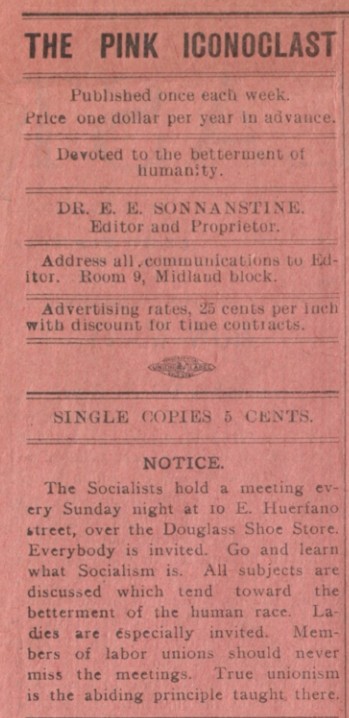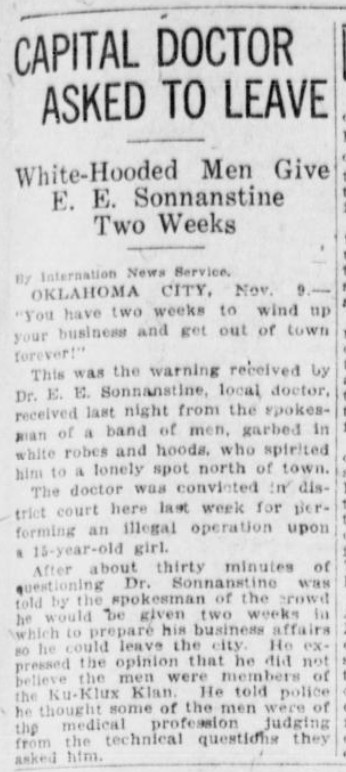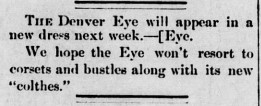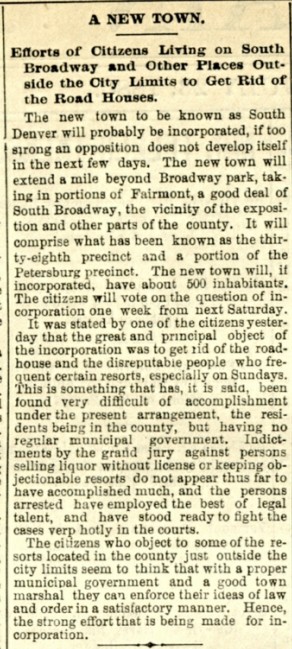The Colorado Historic Newspapers Collection (CHNC) is fast approaching 6 million pages. Generally, the content added to CHNC is funded and selected by our partner organizations found throughout the state. We are very fortunate to have so much support. Occasionally we, the small and mighty team at the Colorado State Library, are able to select a few of our own additions. All additions add value to Colorado’s historic narrative but some deserve a deeper dive.
The Pink Iconoclast
Have you seen our recent addition – The Pink Iconoclast? The issue dated August 22, 1903, is actually pink! This is the only issue of the Iconoclast we have ever seen and it took us on quite a journey. The Iconoclast was published by Emmett Elan Sonnanstine, an early proponent of the socialist movement and a self proclaimed “Turk” doctor – though it is said that no records exist of him ever attending medical school. The name “Pink Iconoclast” likely reflects both the socialist ideology and the anti-establishment nature of the publication.
Little is known about Sonnanstine but a quick search of the historic newspapers revealed so many more details. Between 1899 and 1901 Sonnanstine seems to have been moving around Colorado lecturing, seeing patients, and providing “good musical entertainment”. During the fall of 1901 he was legally forced to leave Fort Collins for practicing medicine without a Colorado license. It is thought that Sonnastine published the Iconoclast from 1902 until 1905 in Colorado Springs. By early 1905 he was in trouble with the law again. This time for the grave offense of assaulting a minor. He was sentenced to 5 to 6 years but only a short time after was awarded clemency.
It seems this is when Sonnanstine leaves Colorado eventually spending time in Chicago. In Chicago, Sonnanstine established a “Hobo” College where he often lectured on various Socialists topics that were accompanied by “moving pictures and slides”. According to Sonnanstine a “hobo” was not to be considered a panhandler but rather a “life-loving workman, affected with wanderlust”. He continued to run afoul of the law and in 1921 was convicted of performing an illegal operation on a 15 yr old girl in Oklahoma City. For this he was run out of town by a “band of men in white robes and hoods” though he didn’t believe they were members of the KKK. Shortly after this he was never seen again. One source states that Sonnanstine eventually fled the country for Cartagena, Columbia where he died in 1927 at age 62.
The Denver Eye

“The oldest established suburban paper in Arapahoe County”, the Denver Eye, had various names. Arthur Pierce, founder and editor, seems to have published its first issue in April of 1886 as the Denver Eye. On March 5, 1887, the Crystal River Current reported that the paper had a new “dress” – the Eye. Sometime between then and January 1, 1890, the first issue in CHNC, the name changed back to The Denver Eye and was reporting on South and West Denver news. CHNC’s next issue, May 6, 1893, has The South Denver Eye on its masthead and the focus of the paper shifted slightly to just South Denver. By January 7, 1899 the name was again changed back to The Denver Eye. The name changed again to South Denver Eye & Bulletin from 1904-1928. Harry Risley owned the Eye from 1907 to 1927 and sold the paper in March 1927.
South Denver was formally incorporated on July 31, 1886. The effort to incorporate was organized by James Fleming, Rufus Clark, and Avery Gallup in early 1886 in response to the saloons, dance halls, and gambling establishments near Denver’s Overland Park, to allow the area to legally enforce anti-vice laws. Fleming, originally from Pennsylvania, created an alcohol free community by using much of his own wealth to develop the area. The effort to incorporate was opposed by many and led by former Rocky Mountain News owner William Byers who brought suit twice with both cases being dismissed by the courts.
Though somewhat loose for years, South Denver’s formal boundaries were Alameda and Yale Avenues to the north and south respectively and Colorado Boulevard to the South Platte River from east to west. Early reports indicate that the boundaries were further north of Alameda avenue. In all, the community’s almost 12-square-mile area made it the largest of Denver’s suburbs. Despite Mayor Flemming generosity of wealth the city went into debt due to costly city improvements and suffered further as a result of the 1893 Silver Panic. South Denver was not alone, the suburbs of Highlands, Colfax, Elyria, Globeville, Argo, Montclair and Valverde were all facing the same decision. The South Denver residents voted to approve annexation by Denver on February 7, 1894.
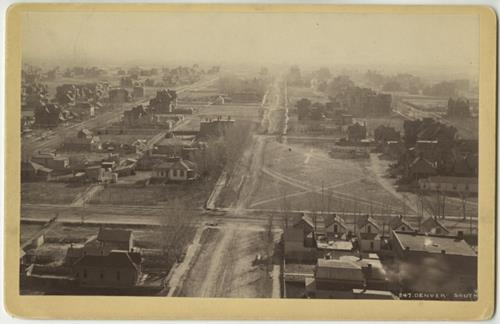
The CHNC collection of the Eye begins with a special holiday edition that acts as one large advertisement enticing people to move to the suburb. The issue reports on the area residents, the recent homes built, the companies that built and furnished them and the “Abundance of Pure Water, Pure Air, No Rum.” Many of the homes illustrated in the edition are no longer standing. The remaining 76 issues document life in a Denver suburb and report on issues relevant to its residents – local events, politics, city improvements, and state and national news. Today, portions of what was once South Denver now encompass the adjacent University and University Park neighborhoods of Denver.
If you have questions about CHNC don’t hesitate to reach out to me, Leigh Jeremias, jeremias_l@cde.state.co.us.
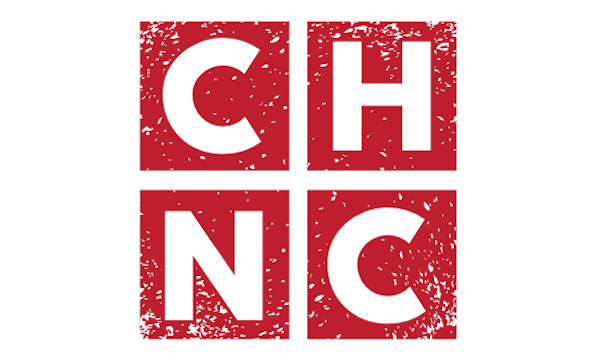
- Touring US Collections: Free Access to History - July 30, 2025
- It Takes a Village: New News for Weld and Pitkin Counties - June 26, 2025
- Socialism and a Denver Suburb: New Additions to CHNC - June 6, 2025
